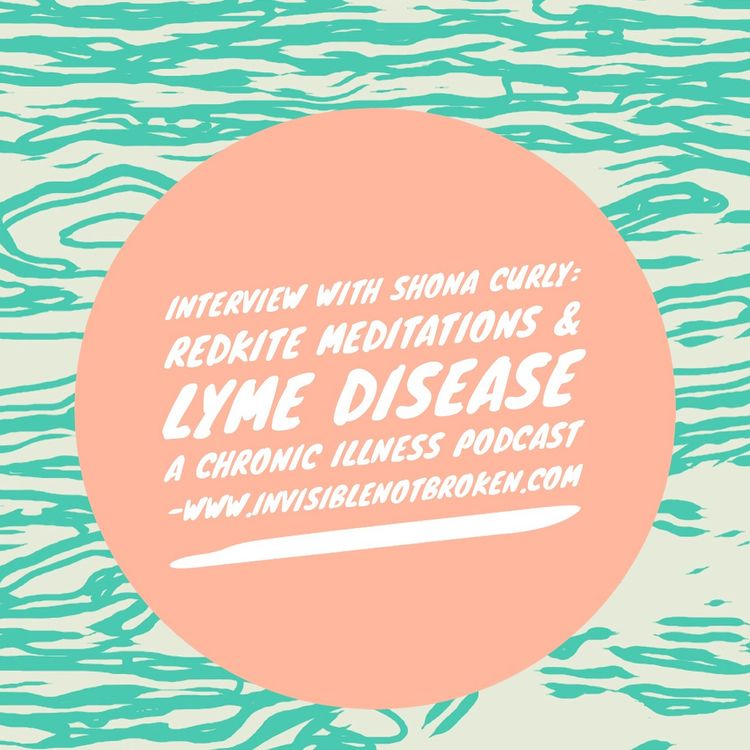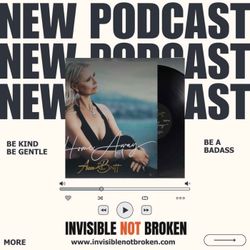Share

Invisible Not Broken - Chronic Illness Podcast Network
Interview With Shona Curley From Red Kite Meditations on Lyme Disease
Find Out More About Shona & Follow Her:www.redkitemeditations.com Instagram FaceBook
What is your disorder? *
At what age did your disorder become a daily issue? *
40
Who were you before your illness became debilitating? *
A busy mom of two little kids, a self employed Pilates studio owner and teacher, a rock climber, runner and ex modern dancer.
What would you do if you were not dealing with your invisible illness? *
I would be working more at my Pilates studio! I'd be running, rock climbing and going out dancing more often. I'd be generally out and about more, seeing friends, eating dinners out (that perhaps contained grains or sugar). I can't wait to get all my energy back and live fully again like this.
What would you like people to know about your daily life? *
My meditation practice has been my saving grace. It has given me something productive to do with my mind when regular life is not an option. It has helped me learn about my history, my emotions, my body and my patterns, and has given me a way to affect change for the better even when feeling unwell.
What would make living and moving in the world easier for you? *
If health insurance covered Lyme treatment, and if doctors recognized the disease. I have had to spend buckets of money from savings on treatment in order to recover.
Do you have any life hacks? *
A billion! Meditation first of all, visualization in particular. Movement. Watching and guiding my thought patterns so they support my health. Processing old trauma patterns. Paleo diet, herbs. Stress reduction!!
What kind of support do you get from family or friends? *
A ton from family. Because of family support I have been able to take time off work, get treatment, rest as much as I have needed to. Friends have been more difficult, because I have been too tired to invest while I am busy healing.
Have you ever had someone not believe you have an invisible illness because of your appearance and if so are there any examples that stand out? *
Not because of my appearance, but just because doctors don't believe chronic Lyme exists.
How has your invisible illness affected your relationships? *
It has probably made my marriage better over time, due to my own increased humility and compassion. It has been hard on my friendships, because I have needed so much time alone resting.
Is there anything you are afraid to tell people in your life? *
Not really, though I do think it is important to talk about how unprocessed trauma can lead to chronic stress, which can make you more susceptible to chronic illness.
Does the fact that your disease is invisible change how healthcare professionals treat you? *
No, because I ditched all asshole conventional doctors and only see my naturopath LLMD
What is your best coping mechanism? *
Meditation.
What are you the most concerned about and the most hopeful for in the future? *
Remission!! I want to get there!! I feel it in my future!!
What is your favorite swear word?
Good question. I like them all.
Is there anything you want to make sure we talk about during the interview? Like an organization you want to promote or something specific that you deal with.
Definitely my meditation / visualization practice, and The Cells' Breath, my album of guided visualizations for peeps with chronic lyme, available through Red Kite Meditations my site, and iTunes.
What is the hardest and/or best lesson your condition has taught you?
To value every single moment of feeling happy, joyous and well. To lean in to happiness!! And that perfect health is a fantasy that can be oppressive.
What is the best purchase under $100 that helped your life
Well, I personally spent a whole lot more than 100. making it, but my album of meditations saved my butt, and it's only $14.99 for others.
More episodes
View all episodes

Musician Ann-Britt Celebrating New Music, Creativity and Chronic Illness, and Creating New Goals
53:21|SummaryIn this conversation, Monica Michelle and Ann-Britt discuss their shared experiences with chronic illness, particularly Ehlers-Danlos syndrome. They explore the challenges of living with a chronic condition, the importance of community support, and the therapeutic role of music in coping with illness. Ann-Britt shares her journey from being an active musician to adapting her life around her health challenges, including the use of a wheelchair. They also touch on the differences in healthcare systems between Denmark and the USA, emphasizing the need for better understanding and support for those with chronic illnesses. In this conversation, Monica Michelle and Ann-Britt discuss the challenges of traveling with a disability, the emotional journey of adapting to life changes due to chronic illness, and the importance of setting boundaries. They explore generational differences in self-care, the concept of diminished normalcy, and the emotional ties to home. Ann-Britt shares her musical inspirations and the themes of her upcoming album, highlighting the beauty in small moments and the power of creativity in the face of adversity.Keywordschronic illness, Ehlers-Danlos syndrome, mental health, creativity, music therapy, wheelchair use, healthcare systems, Denmark, USA, community support, chronic illness, accessibility, self-care, personal growth, music, life changes, boundaries, emotional health, travel experiences, generational differences
Author of “Finding A New Normal: Living Your Best Life with Chronic Illness”: Suzan Jackson
49:39|Monica Michelle is joined by author Sue Jackson.Sue lives with Myalgic encephalomyelitis/chronic fatigue syndrome (ME/CFS) and Lyme disease.In this episode, Monica and Sue discuss: Sue’s pathway to diagnosis Parenting with chronic illness and parenting a child with chronic illnessManaging ME/CFS from diagnosis to creating routinesUsing books to cope emotionallyWriting a book while having chronic fatigueTIMESTAMPS00:46 Sue’s diagnosis and how she manages her symptoms 13:03 Parenting with a chronic illness25:02 COVID-19’s impact on chronic illness 30:35 Books as a form of escapism and connection42:00 The challenges of writing and the importance of routines with chronic illness The full transcript and all links mentioned can be found on the episode page on invisiblenotbroken.com
Using Self-Portraits to Represent Chronic Pain
01:00:29|Monica Michelle is joined by artist Kyrianna Bolles.Kyrianna lives with chronic pain.In this episode, Monica and Kyrianna discuss: Kyrianna’s struggle to be accommodated for her pain throughout school yearsHow Kyrianna uses her portraits to help represent other’s chronic conditionsThe communities Kyrianna has built, from a college support group to an artist collectiveKyrianna’s favorite tools for art and chronic painTIMESTAMPS00:00 Intro to Kyrianna 10:45 Kyrianna’s self portraits 24:42 Kyrianna’s Support group 33:40 Animus45:57 Kyriannas favorite support tools The full transcript and all links mentioned can be found on the episode page on invisiblenotbroken.com
Dory’s Corner: New Podcast intro with Host Nick Clemmons
01:00:25|Monica Michelle is interviewed by consultant and content creator Nick Clemmons. Nick recently started the blog Dory’s Corner with Invisible Not Broken. A companion podcast hosted by Nick will be released soon.Nick lives with Sickle Cell Disease. Monica lives with Ehlers-Danlos Syndrome, POTS, MCAS, and Fibromyalgia.In this episode, Nick and Monica discuss:Monica’s diagnostic history and her relationship with her disabilitiesHow Monica learned to advocate for herselfLack of media representation influencing abled people’s perspectives of disabled folksHow Monica’s family functions around disabilityTIMESTAMPS00:42 - Monica’s history and relationship with her disabilities13:06 - How Monica found her voice *Trigger Warning: Mention of SA* 31:40 - Media representation45:09 - Monica’s familyThe full transcript and all links mentioned can be found on the episode page on invisiblenotbroken.com
Disability Access in the Education System and How to Support Disabled Folks’ Needs with Nick Clemmons
54:05|Monica Michelle is joined by consultant and podcast host Nick Clemmons.Nick lives with Sickle Cell Disease.In this episode, Monica and Nick discuss:The ways disabled folks are often forgotten in education infrastructureHow Nick navigates societal limitations to achieve his goalsDisability representation in the mediaKnowing how to realistically offer help to disabled folksTIMESTAMPS00:42 - ADA, Title IX, and disability access in schools20:08 - How Nick makes and achieves opportunities 28:40 - Media and disability40:42 - How to respectfully be concerned about someone else’s needsThe full transcript and all links mentioned can be found on the episode page on invisiblenotbroken.com
Vulnerability, Resiliency, and Advocacy with Tim Reitsma
47:06|Monica Michelle is joined by consultant and podcast host Tim Reitma.Tim lives with Crohn's Disease.In this episode, Monica and Tim discuss: Tim’s resiliency through managing his Crohn’sThe importance of self-advocacy, especially in the workplace Tim’s podcast why he shares stories of those with invisible illness TIMESTAMPS00:47 - Tim's diagnosis 06:31 - How and why Tim applies self advocacy15:41 - Why Tim started his podcast22:42 - Invisible condition etiquette31:00 - What HR can do better for employees with invisible illness39:31 - Tools Tim uses to care for his Crohn’s outside the homeThe full transcript and all links mentioned can be found on the episode page on invisiblenotbroken.com
Tech and Disability: What VR Offers the Disabled Community with Sunny Ammerman
01:10:27|Monica Michelle is joined by artist and disability advocate Sunny AmmermanSunny lives with Septo-optic dysplasia, panhypopituitarism, Optic Nerve Hypoplasia, and is missing a membrane in the brain called the "septum pellucidum".In this episode, Monica and Sunny discuss: Sunny’s complex disorders and how she copes with themEverything VR provides from accessible gaming, social platforms and the potential for better online education.Various VR/AR games and their gameplay Sunny’s VR support groupTIMESTAMPS00:45 - What VR/AR offers for chronically ill and disabled folks11:57 - Sunny’s conditions and how she copes with them17:55 - Features that make VR games accessible or inaccessible as well as different games and their play experiences37:13 - The social aspects of virtual gaming51:32 - What opportunities VR has for the future1:04:49 - Sunny’s VR support group The full transcript and all links mentioned can be found on the episode page on invisiblenotbroken.com
Reporting on Chronic Illness and Disability with Journalist Julia Metraux
39:16|Monica Michelle is joined by Journalist Julia Metraux.Julia lives with vasculitis, mild to moderate hearing loss, and has experienced long COVID.In this episode, Monica and Julia discuss: Julia's diagnosis with vasculitis and how it influences her journalistic lensHow community impacts the mental health of those with chronic illnessHow Julia and Monica find positives and negatives in the internet spaces for chronically ill and disabled folksThe politics of how government, businesses, and celebrities influence the chronic illness community TIMESTAMPS00:32 - Julia's diagnostic journey07:02 - Julia’s work reporting on the online community of chronic illness 16:32 - The effect of Internet communities on chronically ill and disabled folks26:46 - How Julia’s illness impacts her work, both in what she writes about and how she manages her lifestyleThe full transcript and all links mentioned can be found on the episode page on invisiblenotbroken.com
Author of “Pain: The Ultimate Mentor,” Physiotherapist Kevin Hunt
31:29|Monica Michelle is joined by author & physiotherapist Kevin Hunt.Kevin lives with chronic pain.In this episode, Monica and Kevin discuss: Kevin’s philosophy of pain management as a physiotherapist who experiences chronic pain. The Hexagon Model, a life-management tool for focusing on what’s important to you.Kevin’s idea behind his new book.Using pain as a guide.TIMESTAMPS00:34 - Kevin’s work as a physiotherapist specializing in the experience of pain 06:44 - The Hexagon Model for managing your life’s needs14:00 - Putting aside the idea of a “quick fix”19:45 - Kevin’s personal experience with pain and how he uses it with patients28:44 - Kevin’s book, “Pain: The Ultimate Mentor”The full transcript and all links mentioned can be found on the episode page on invisiblenotbroken.com